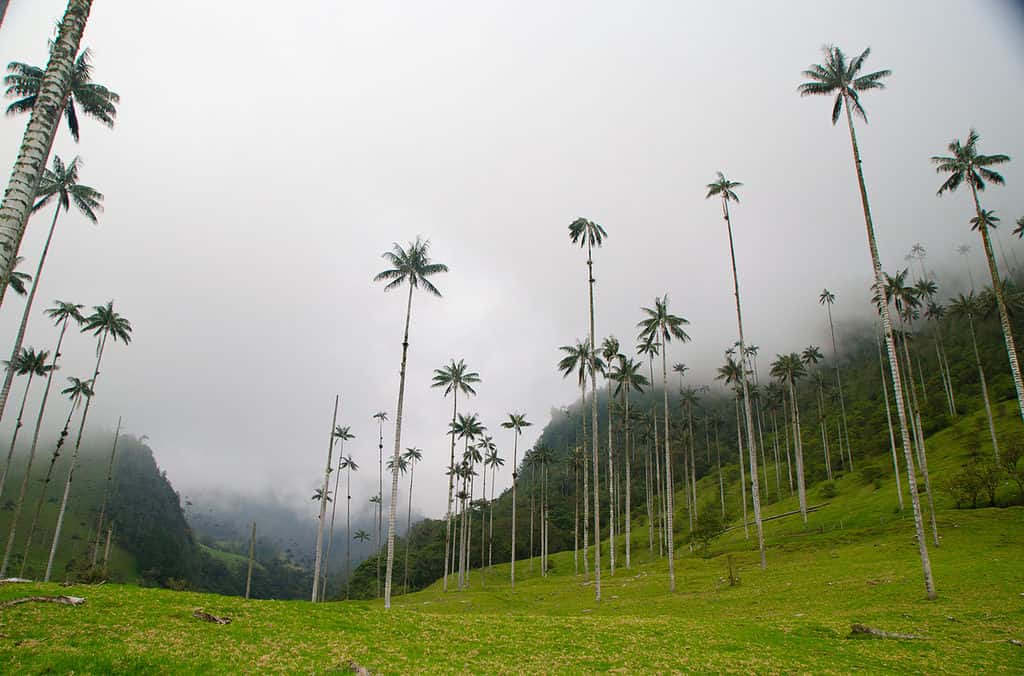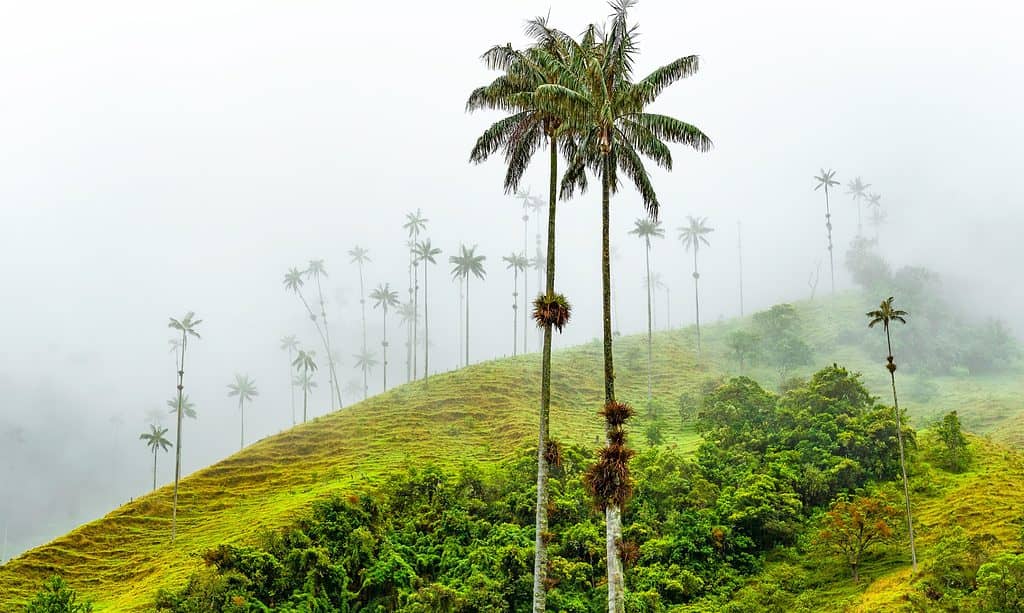Florida, and places like Southern California and Hawaii, are renowned for their population of palm trees, belying their more tropical climates and beachside locales. However, despite the ubiquitousness of palm trees in these areas, the title of “tallest palm tree” lies in another part of the globe entirely.
The Cocora Valley in Colombia is home to “palmas de cera,” so-called wax palms, reaching heights up to 190 feet tall. Read on to learn more about Colombia’s national tree and the history of the world’s tallest palm tree.
What are Palm Trees?

Palm trees grow by adding leaves at the top of the step.
©iStock.com/Sophie Dover
Palm trees are monocots: a group of flowering plants that lack what’s called cambium. Cambium is a type of tissue that allows for the continuous growth of height and diameter and is responsible for forming rings on tree trunks. Instead, monocots like palm trees grow by adding leaves at the top of the step, which limits their ability to widen in diameter. Because of this, out of the more than 2,500 species of palm trees, only a select few can grow more than 130 feet tall. The tallest of this handful is the Quindio wax palm.
Tallest Palm Tree in the World

The tallest palm tree in the world is the Quindio wax palm.
©iStock.com/SL_Photography
Discovered in the 1800s, the Quindio wax palm (scientifically called Ceroxylon quindiuense) has stood proud as the world’s tallest palm tree. When it was first discovered, measurements on specific trees were hard to find. However, recent studies have measured wax palms in the Cocora Valley as tall as 187 to 194 feet. Historical accounts of the species report even greater heights – up to 196 feet – though the accuracy of these reports is questionable, lacking modern measurement tools.
Wax palm trees grow at an astonishing altitude of 1,500 to 3,000 meters above sea level and make their home among the Cocora Valley’s stunning greenery and mountain views. The Cocora Valley nestles in the Colombian Andes in Los Nevados National Natural Park. Some wax palms are also found in the Tochecito River Valley, near the country’s coffee-growing region and approximately 185 miles west of the capital city of Bogotá.
Getting to the Valle de Cocora
The wax palm trees of Valle de Cocora are a must-see stop for those visiting Colombia. The nearest city to the national park is Salento, located nearby Armenia and Pereira, which are both reachable by plane or bus. Many visitors will fly from Medellín or Bogotá to one of the two cities and then take a bus or “buseta” – as the locals call it – to the town of Salento.
Once in Salento, visitors can travel to Cocora Valley by purchasing a ride in a Jeep Willy. There are usually a few of these transportation services available, with kiosks selling tickets to take travelers the 20-30 minute driving distance to Los Nevados National Natural Park. It only costs about $1.50 to visit, and beholding the tallest palm tree in the world is a sight worth seeing.
Tallest Palm Tree in Florida
Dozens of palm tree species thrive in Florida, varying in appearance and size depending on the type. Dwarf palmettos are one example of miniature palm trees growing no taller than three feet. Conversely, giant palm trees can stretch up to 100 feet tall, towering above their fellow palms.
Florida has an excellent climate in which palm trees can grow. However, Central Florida is home to the most frequent lightning strikes in the U.S., which are likely to strike the tallest palm trees in Florida. These can destroy otherwise towering specimens, but quite a few tall trees have survived the storms.
Tallest Palm Tree in California
California’s Mediterranean climate, primarily temperate weather, and plentiful sunshine make it a perfect region where tall palm trees make their home. Washingtonia filifera, the desert fan palm, is native to the hot aridity of southern California’s deserts, where they can live up to 90 years. These plants stretch up to 75 feet tall and are one of the most towering palms native to North America. They’re also one of the heaviest, with their nearly six-foot-long leaves weighing as much as three tons.
The Mexican fan palm, Washingtonia robusta, proliferates all over Los Angeles and Southern California and stretches up to 98 feet tall. However, they are not native to the region. The date palm (Phoenix dactylifera) is also a fast grower and can reach up to 80 feet.
Tallest Palm Tree in Hawaii
In Hawaii, the region’s most giant palm tree is called Schattauer’s loulu or Pritchardia schattaueri. It’s part of the Pritchardia genus and native to the southwestern forests of the island of Hawaii. This species reaches up to 130 feet tall with a smooth, gray trunk about a foot thick. Sadly, these tropical giants are on the critically endangered species list.
Where is The Cocora Valley Located on a Map?
The Cocora Valley, situated in the Quindío Department of Colombia, is a valley located in the Andean mountains’ Central Cordillera. The valley was named after a Quimbayan princess named “Cocora,” who was the daughter of a local chief named Acaime. The name “Cocora” translates to “star of water.”
Here is The Cocora Valley on a map:
The photo featured at the top of this post is © iStock.com/SL_Photography
Thank you for reading! Have some feedback for us? Contact the AZ Animals editorial team.






